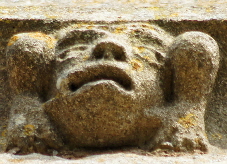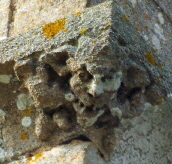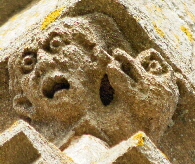|
|
||||||||||||||||||||||||||||||||||||||||||||||||||||||||||
|
Please sign my Guestbook and leave feedback |
||||||||||||||||||||||||||||||||||||||||||||||||||||||||||
|
Recent Additions |
||||||||||||||||||||||||||||||||||||||||||||||||||||||||||
|
When I wrote my first edition of this narrative I knew of seven churches with flea carvings. Within the MMG they were at Oakham, Buckminster, Whissendine, Cottesmore, Hungarton and Langham. I had also found one at Brant Broughton quite a way north of the MMG area, a church where the superb friezes were clearly by John Oakham. Since then I have found the flea at four more churches: at Exton within the MMG, at Harlaxton some way north of the MMG and at Swineshead and Leverton, both a long way east of both the MMG area and Brant Broughton. So, no fewer than eleven in all, seven within the geographical area of the MMG and four without. Having, in the first edition, simply observed that the flea was a characteristic of many MMG friezes, their ubiquity now demands an explanation. With four flea carvings appearing at churches that do not have the mark of the Mooning Men group upon them it becomes quite clear that they are the trademark of a stonemason who was sometimes a member of the MMG lodge and sometimes not. That stonemason was assuredly John Oakham. John’s most distinctive motif is the “cow-lion” face. And where we see that motif, with one exception, we always see a flea carving. That means at Whissendine and Oakham (within the MMG) and at Leverton and Swineshead in the Boston area outside the MMG area. The exception is Boston itself. I think that anomaly can be explained quite plausibly. At the all of the other four John was clearly the dominant sculptural mason. In fact at Leverton and Brant Broughton he was the only sculptural mason. Boston was a church that was completely rebuilt and has enormous quantities of sculpture. At that location John was prolific but far from dominant.. And then it all becomes much more difficult. Three churches within the MMG, as we have seen, share the distinctive sculptural designs of the man I call Simon Cottesmore. Simon had his own sculptural calling card: the batwinged lion that is always found at the extreme corbels of his friezes. “His” churches are Cottesmore (of course!), Buckminster and Humngarton and their “look and feel” is very distinctive. And all of these churches have a flea carving as well and no signs of John Oakham’s cow-lion faces. In fact Cottesmore has three flea carvings, the only church with more than one. Was the motif shared by two masons? Were the two masons, in fact, one? I think we can easily dismiss the notion that the two men were one. The gap between the styles is just too large. Each of those three churches, however, had more than one sculptor at work. At Cottesmore, that is far from obvious but in fact the north aisle frieze, at close examination, different in its sculptural style, if not in theme. And that style is also seen on the south aisle at nearby Whissendine and also at Oakham. |
 |
|
South Aisle, Whissendine Church |
|||||||||
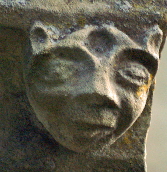 |
 |
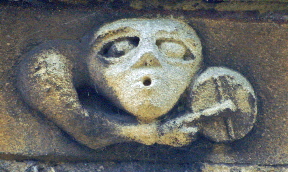 |
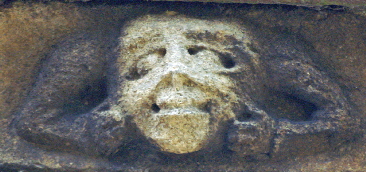 |
||||||
|
|
 |
|
Length of Frieze, North Aisle Oakham Church by John Oakham |
|
So John Oakham was at Cottesmore and this explains why we see a flea there. What about Buckminster? Well, there’s a second carver there as well - not on the frieze which is only on the south west of the church, but on the ornate south porch. |
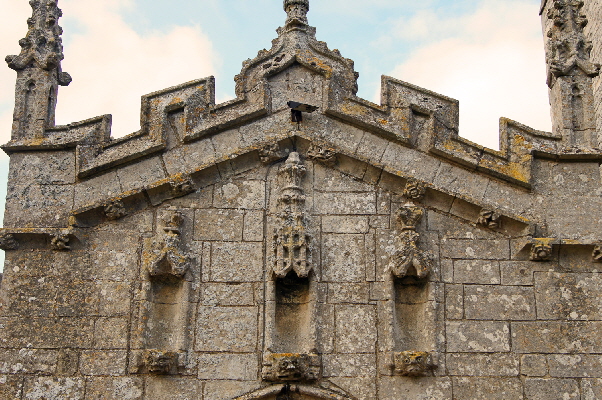 |
|||
|
Buckminster, South Porch attributable to John Oakham. |
|||
|
The carvings on Buckminster’s porch - both the short frieze and the decorated (but empty) niches are, again, completely different from Simon Cottesmore’s friezes there and much closer to John Oakham’s cow-faces and more sophisticated fleuron designs. Hungarton is more difficulty. There is only a tower frieze and Simon Cottesmore clearly carved a lot of it. Once again. however, there is a second sculptural style. |
|
|
||||||||||||||||||||||||||||||||||||||||||||||||
|
The “second mason” at Hungarton encapsulates some of our perennial problems. Because the lengths of cornice that comprise a frieze are usually short with no more than one or two carvings we can sometimes be unsure as to whether one or two masons contributed. Moreover, we have no real knowledge of the full range of work carried out by a decorative mason. Although it seems a reasonably safe bet that most of the decorative masons worked as ordinary hewers and layers most of the time, when we see the extensive work of John Oakham at Oakham and Brant Broughton, for example we might imagine a man being used exclusively as a decorative mason. At Boston he was clearly one of a number of such masons. At Hungarton he must have been primarily a structural mason as the decorative work is so sparse. Remember too that the setting of window tracery was another area of work for the most skilled of men. It is no surprise that John was denied the opportunity to leave his trademark at the grandiose Boston Church. At Leverton it would have been hard to stop him, one imagines. Moreover, although the evidence is overwhelming that the flea carving is personally associated with John Oakham, that does not mean that he was the mason that invariably carved it. At Cottesmore there are three fleas. All three of those lengths of frieze carved by Simon Cottesmore has a flea, the one apparently carved by John does not! The same is true at Buckminster where John apparently carved only the south porch and not the cornice frieze. Or did John personally carve the flea and leave the rest of the frieze to Simon? Did he do the same at Cottesmore? It seems we can rely on no more than the fact that if a church had a flea carving then John was there, It does not, however, follow that wherever John worked he also left a flea - as we see at Boston. Seeing his work within the MMG (as opposed to outside it which I cover comprehensively in the next section - The Peregrinations of John Oakham) I have a very strong suspicion that he and Simon Cottesmore were collaborators and, given John’s clearly superior skills, John was surely the senior man. It might have been just a case of two masons who had a professional connection or it might be that Simon was John’s son or nephew (but - please - not apprentice!). Let’s just settle for “acolyte”. |
|
Recommended Next Section: The Peregrinations of John Oakham |
|||
|
Church Building in the Post-Plague Era Scratching those Fleas (You are Here!) |
|||
